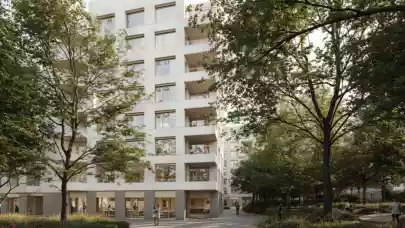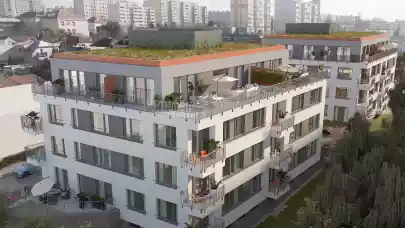
The key pandemic-related trends on the Polish office market of 2020 include the transformation of the way work we work and where we work. This prompted many occupiers to redefine their needs regarding the size of the office and the way the office is arranged. Equally important was ensuring workplace safety, also through new technological solutions. As a result of the pandemic and the lockdown measures, both development and leasing activity decreased slightly last year. Demand came mostly from new contracts and renewals. The AXI IMMO advisory firm summarises market conditions in 2020 and explores current office space trends in Poland.
The supply of space on the office market in 2020
At the end of 2020, total modern office stock in Poland amounted to over 11.7m sqm. Traditionally, Warsaw, with about 5,912,500 sqm, was ahead of eight major regional markets combined (approx. 5,790,000 sqm). Kraków remains the leader among the regional cities (1,554,900 sqm), ahead of Wrocław (1,226,300 sqm) and the Tri-City (888,600 sqm). In the last quarter of 2020, 163,400 sqm was delivered to the Polish office market, which includes 75,800 sqm across three projects in Warsaw and 87,600 sqm across six buildings in regional cities. The largest scheme completed in 2020 was Mennica Legacy Tower (47,900 sqm, Golub GetHouse), as well as Yereal Lixa A (22,100 sqm) and Lixa B (approx. 5,800 sqm), which were all delivered in Warsaw. Other large new completions include Face2Face B (approx. 26,200 sqm, Echo Investment) in Katowice, Hi Piotrkowska (21,000 sqm, Master Management Group) in Łódź and Unity Tower (15,600 sqm, GD&K Group and Eurozone Equity) in Kraków. New supply in the entire 2020 in Poland amounted to 700,700 sqm, of which Warsaw accounted for 307,400 sqm, Krakow – 140,700 sqm, Katowice – 61,300 sqm, Tricity – 60,300 sqm, Wrocław – 57,200 sqm, Łódź – 51,500 sqm, Poznań – 18,300 sqm. and Szczecin – 3,400 sqm.
“As a result of the pandemic, we observed lower development activity on the Polish office market compared to previous years. Developers and investors are much more cautious about starting new projects, mostly basing their decisions on the occupancy level of existing office space. In Warsaw and regional cities, some of the planned buildings will be postponed, and their construction will depend on the market situation. Moreover, sub-letting has become a clear trend, driven by general market uncertainty due to lockdown measures and the rise of remote working, both of which influenced occupiers’ strategic decisions regarding office space.. According to our estimates, as much as 100,000 sqm was subject of sub-let in Warsaw alone last year”, says Martin Lipiński, Head of Office Agency and Tenant Representation, AXI IMMO.
Available offices for rent
New office space delivered to the market in 2020 pushed the vacancy rate up slightly. There is currently approximately 1,320,100 sqm of vacant office space in Poland, which accounts for 11.3% of the total market resources. At the end of Q4 2020, Warsaw’s vacancy rate reached 9.9% (+30 bps q/q and 210 bps y/y) and amounted to approx. 583,500 sqm. of available space. In the regions meanwhile, 736,600 sqm was available for lease as at the end of 2020, which is an equivalent of 12.7% of total stock (+80 bps q/ q and 310 bps y/y). In percentage terms, the highest vacancy rate among the eight regional cities was recorded in Łódź – 16.4% (94,600 sqm), followed by Wrocław – 14.9% (183,400 sqm) and Kraków – 13.9% (217,500 sqm). The lowest vacancy was seen in Szczecin – 6.9% (12,600 sqm), Lublin – 7.8% (14,300 sqm) and Katowice – 9.1% (54,000 sqm).
„In the context of new supply and the forecasted new vacancy rate, 2021 should be interesting. The two largest schemes that are currently under construction in Poland – the Varso Tower and the Forest building by Slovak developer HB Reavis in Warsaw – should be completed at the end of the year. As a result, late 2021 and early 2022 will see very significant oversupply of office space in Warsaw,” comments Jakub Potocki, Negotiator, Office Agency, AXI IMMO.
„As for the new business centre of Warsaw, the Wola district, it is worth mentioning that in January 2021 the occupancy permit was granted to the 195-meter Skyliner skyscraper by Karimpol. Next projects in the pipeline are Generation Park Y by Skanska and Warsaw Unit by Ghelamco. Also, the mixed use Norblin Factory by Capital Park, will be delivered in 2021 near Rondo Daszyńskiego. As a result of the completion of these schemes, supply will increase by approx. 190,000 sqm, some of which had already been leased,” adds Bartosz Oleksak, Negotiator, Office Agency, AXI IMMO.
What is the rent for an office?
„The situation may force landlords to reduce headline rents, especially in B-class buildings and those schemes that have inferior road and public transport infrastructure. In addition, we expect further increases in incentives for new occupiers – a trend we have observed in the last few months. More than ever before, this is an occupier-led market. It is the first time in the modern history of Polish offices that occupiers have this much bargaining power and this many opportunities when negotiating new lease agreements,” continues Jakub Potocki.
Demand for office space
Total gross take-up on the Polish office market amounted to 1,184,200 sqm last year. Leasing transactions totalling 602,000 sqm were closed in the capital city (-31% y/y), with 160,400 sqm of lease agreements signed in the last quarter. Meanwhile, take-up in all key regional office markets amounted to 582,200 sqm in the entire year, of which 107,000 sqm (-26% y/y) was closed in the fourth quarter. Among the regions, the highest occupier activity was recorded in 2020 in Kraków (156,600 sqm), Wrocław (128,400 sqm) and the Tri-City (87,700 sqm). Despite a marked drop in demand, both in the capital city and the regions, large transactions were closed, including a pre-let agreement for 46,600 sqm. by PZU in the Generation Park Y building in Warsaw, renewal of Nokia Siemens Network lease in the West Gate and West Link buildings (nearly 30,000 sqm) in Wrocław and a pre-let agreement signed by Allegro in Q4 2020 in Poznań’s Nowy Rynek D1 (26,000 sqm).
2020 a year of challenges, 2021 a year of hope for a return to normal
“The office market situation in 2020 can be described as a time full of challenges that brought us many new experiences. Firstly, we raised the standards of occupational health and safety. Compulsory lockdown made our approach to the office as a workplace more flexible. The home office has become an integral element in the life of virtually every company. As a consequence of these events, each of us came to believe that technology is our ally and that it is difficult to function without it today. Further tech solutions facilitating our remote work are a matter of time. Many occupiers decided to increase the average space per employee, which resulted in a change in the standard of office space arrangement and increased working comfort. In terms of spending time in the offices, employers are likely to move away from a “You must” approach to “I encourage you”. Maintaining relationships or, in the case of new employees, building relationships and training will be seen as key advantages of office space. The most important lesson from the pandemic was that new large leasing contracts continued to be closed. The signed transactions give hope that everything will return to normal in due course,” sums Martin Lipiński.



